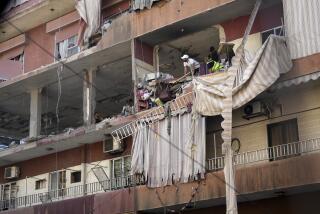Ex-Admiral Projects 10,000 U.S. Deaths in a 6-Month Iraq War : Scenario: Now head of think tank, he tells Congress of potential $80-billion cost.
- Share via
WASHINGTON — A six-month war against Iraq would result in the deaths of 10,000 American soldiers, the wounding of 35,000 others and direct military spending of $80 billion, a retired Navy admiral told a congressional committee Tuesday.
But U.S. forces should be able to oust President Saddam Hussein and capture the Iraqi capital of Baghdad in about half that time, or roughly three months, according to a prospective scenario prepared by the Center for Defense Information (CDI).
The private think tank’s director, retired Rear Adm. Gene R. La Rocque, outlined the projections as Congress began to weigh the potential costs--both human and financial--of initiating military action in the Persian Gulf crisis.
His estimates, which he described as the “best professional judgment” of military specialists at the center, deal with information considered highly sensitive by the Pentagon and rarely discussed in public.
Meanwhile, the Pentagon said that Iraq has added 20,000 troops, 100 tanks and 200 artillery pieces to its forces in and near Kuwait but noted that it has detected no signs of the massive buildup of forces announced recently by Hussein.
The additions bring Iraq’s armed strength in and around Kuwait to 450,000 troops, 3,600 tanks and 2,400 artillery pieces, said Pentagon spokesman Pete Williams. Hussein said last week that he intends to boost his forces in the area by about 250,000.
In another development, the Pentagon disclosed that U.S. Navy forces in the Red Sea diverted a German-flagged container ship on Thursday because it was carrying two heavy boxes that could not be opened. The ship’s manifest had been changed several times, a spokesman said, prompting suspicions about its cargo.
The risks of a U.S. military attack on Iraq were outlined at a hearing before the House Banking, Finance and Urban Affairs Committee, which is examining the economic effects of the gulf crisis.
La Rocque, the leadoff witness, painted a stark picture of the consequences of an American-led offensive.
“The likely costs of such a campaign would be high,” he said. “The United States can be expected to sustain approximately 45,000 casualties, about 10,000 of which would be deaths. Iraq would suffer about 150,000 casualties, including 35,000 deaths.
“Arab and European forces would suffer 10,000 to 15,000 casualties. Civilian casualties from bombing and the battle for Baghdad might exceed 100,000.”
Assuming three months of heavy fighting, another three months of low-level conflict and nine additional months of occupation of Iraq, the American military costs would be about $80 billion, he estimated. The figure does not include equipment replacement costs, additional veterans’ support, aid for rebuilding Iraq, higher oil prices or the effect of increased interest rates on the American economy, La Rocque said.
The committee hearing was convened by Chairman Henry B. Gonzalez (D-Tex.), who has advocated a congressional debate on the U.S. role in the gulf and the additional buildup authorized recently by President Bush.
“The remains of the so-called ‘peace dividend’ will be lost in the sands of the Saudi desert,” Gonzalez said. “The federal budget . . . is certain to become even more of a fantasy as the ‘must’ expenditures in the Middle East grow.”
Gonzalez warned that the full costs of Operation Desert Shield will not be known for years. “If full-scale war breaks out, the costs in human and economic terms will be incalculable,” he said.
John Wheeler, president of the nonprofit Center for the Vietnam Generation, speculated that a gulf war might cost as much as $1 trillion when all outlays are counted, including medical care for the wounded. That compares to an estimated $300 billion spent on the Vietnam War, he said.
In his testimony, La Rocque focused on the surge in oil prices since Iraq’s invasion of Kuwait on Aug. 2.
“By keeping oil prices high in the near term and encouraging an increase in Saudi (oil) production, the U.S. intervention has bestowed a large windfall profit . . . on Saudi Arabia,” he said, noting that Saudi oil receipts have increased as much as $180 million a day.
“The additional oil revenues are over twice as much as the U.S. deployment costs, which CDI now estimates to be about $74 million per day,” La Rocque said. “This could become the first U.S. war in which the nations we defended made a handsome economic profit while we paid dearly.”
La Rocque urged that U.S. officials continue diplomatic efforts to reach a negotiated settlement of the crisis for at least a year while economic sanctions remain in effect.
“If after one year Iraq still refuses to agree to reasonable and necessary terms acceptable to the U.N. Security Council, the Security Council should then consider the option of military action against Iraq,” he concluded.
Times staff writer Melissa Healy contributed to this report.
More to Read
Sign up for Essential California
The most important California stories and recommendations in your inbox every morning.
You may occasionally receive promotional content from the Los Angeles Times.













